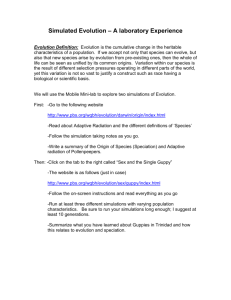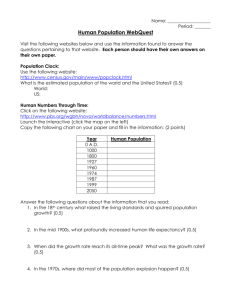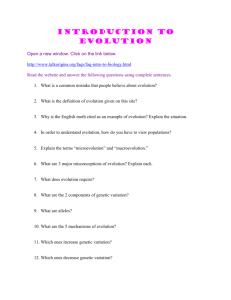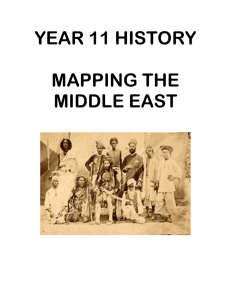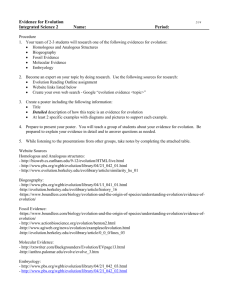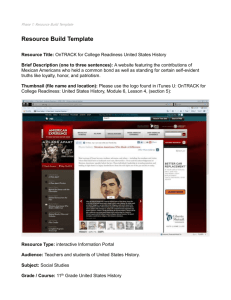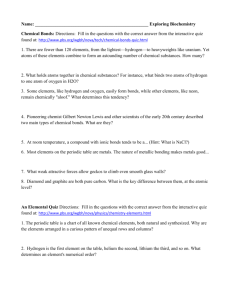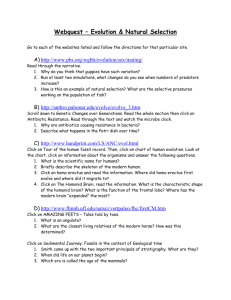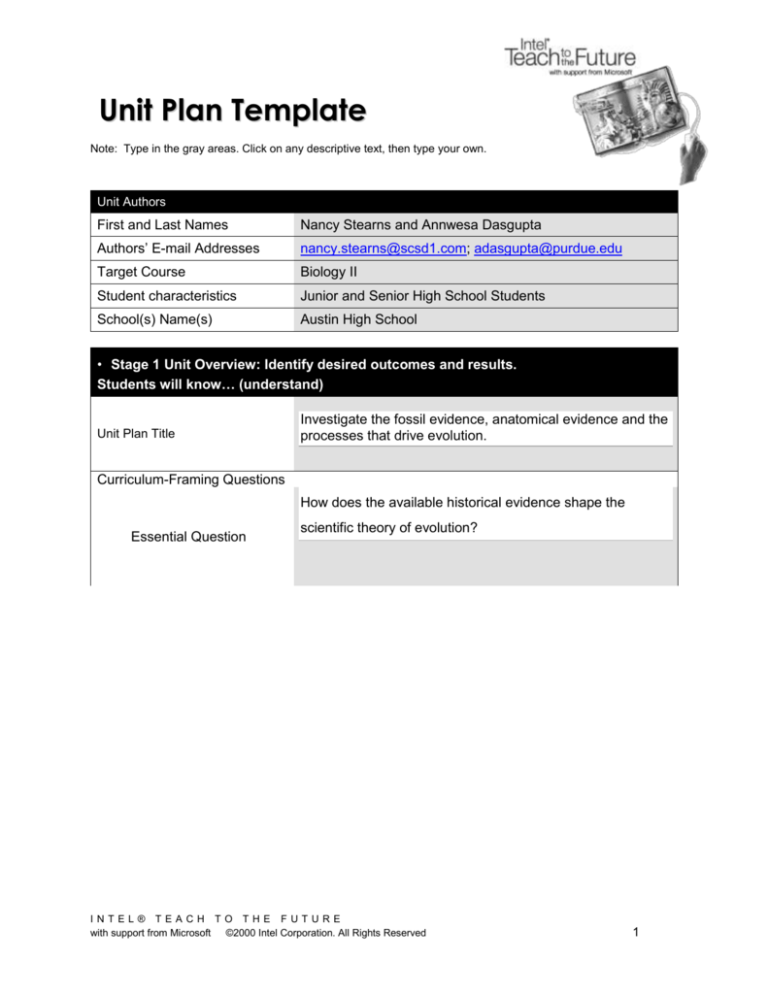
Unit Plan Template
Note: Type in the gray areas. Click on any descriptive text, then type your own.
Unit Authors
First and Last Names
Nancy Stearns and Annwesa Dasgupta
Authors‟ E-mail Addresses
nancy.stearns@scsd1.com; adasgupta@purdue.edu
Target Course
Biology II
Student characteristics
Junior and Senior High School Students
School(s) Name(s)
Austin High School
• Stage 1 Unit Overview: Identify desired outcomes and results.
Students will know… (understand)
Unit Plan Title
Investigate the fossil evidence, anatomical evidence and the
processes that drive evolution.
Curriculum-Framing Questions
How does the available historical evidence shape the
Essential Question
scientific theory of evolution?
INTEL® TEACH TO THE FUTURE
with support from Microsoft ©2000 Intel Corporation. All Rights Reserved
1
1. How does the fossil evidence support the theory of
evolution?
2. What are the typical sequences of events in fossilization
and why are gaps present?
3. How does comparative morphology provide evidence for
evolution?
4. What can the presence of homologous structures signify?
Unit Questions
5. What can the presence of analogous structures signify?
6. What are the four principles of natural selection?
7. How does "The Theory of Natural Selection" provide
evidence for evolution?
8. How a close relationship between species compare to an
escalating arms race?
9. How do unrelated species evolve similar traits even if they
live in different parts of the world?
Unit Summary
Students will investigate the fossil evidence, anatomical evidence and the processes that
drive evolution.
The unit that we are going to teach will include the following topics and concepts:
Investigate the fossil evidence, anatomical evidence and the processes that drive evolution.
-Evidence of Ancient Life: Fossils.
-Evidence of Anatomical Features: Homologous and Analogous Structures.
-Processes that Drive Evolution: Natural Selection, Coevolution, and Convergent Evolution.
The activities designed and incorporated into this unit will walk the students through the major
ideas and developments that have led to the development of the scientific theory of evolution.
The main purpose of this unit is helping students develop their own understanding of
evolution.
Subject Area(s)
English, math, science, social studies, technology.
INTEL® TEACH TO THE FUTURE
with support from Microsoft ©2000 Intel Corporation. All Rights Reserved
2
Grade Level [Click box(es) of all grade level(s) that your Unit targets]
K-2
3-5
6-8
9-12
ESL
Resource
Gifted and Talented
Other:
Targeted State Frameworks/Content Standards/Benchmarks
From the Indiana Department of Education Standards
Standard 8: Evolution
--------------------------------------------------------------------------------------------------------------------Core Standard
Describe how biochemical, fossil, anatomical, developmental, and genetic findings are used
to determine relationships among organisms and how those relationships are then used to
produce modern classification systems. (B.8.1, B.8.2, B.8.3)
Core Standard
Describe how modern evolutionary theory provides an explanation of the history of life on
earth and the similarities among organisms that exist today. (B.8.5, B.8.7)
--------------------------------------------------------------------------------------------------------------------B.8.1 Explain how anatomical and molecular similarities among organisms suggests that life
on earth began as simple, one-celled organisms about 4 billion years ago and
multicellular organisms evolved later.
B.8.2 Explain how organisms are classified and named based on their evolutionary
relationships into taxonomic categories.
B.8.3 Use anatomical and molecular evidence to establish evolutionary relationships among
organisms.
B.8.5 Describe how organisms with beneficial traits are more likely to survive, reproduce,
and pass on their genetic information due to genetic variations, environmental forces
and reproductive pressures.
B.8.7 Describe the modern scientific theory of the origins and history of life on earth and
evaluate the evidence that supports it.
The Nature of Science
Develop explanations based on reproducible data and observations gathered during
laboratory investigations.
Recognize that their explanations must be based both on their data and other known
information from investigations of others.
Explain that the body of scientific knowledge is organized into major theories, which are
derived from and supported by the results of many experiments and allow us to make
testable predictions.
Recognize that new scientific discoveries often lead to a re-evaluation of previously
accepted scientific knowledge and of commonly held ideas.
Explain how scientific knowledge can be used to guide decisions on environmental and
INTEL® TEACH TO THE FUTURE
with support from Microsoft ©2000 Intel Corporation. All Rights Reserved
3
social issues.
Reading Standards for Literacy in Science 9-10 RS
Integration of Knowledge and Ideas
9-10.RS.8 Assess the extent to which the reasoning and evidence in a text
support the author‟s claim or a recommendation for solving a
scientific problem.
9-10.RS.9 Compare and contrast findings presented in a text to those from
other sources (including their own experiments), noting when the
findings support or contradict previous explanations or accounts.
Writing Standards for Literacy in Science
Text Types and Purposes
9-10.WS.1
Write arguments focused on discipline-specific content.
a. Introduce precise claim(s), distinguish the claim(s) from
alternate or opposing claims, and create an organization that
establishes clear relationships among the claim(s),
counterclaims, reasons, and evidence.
b. Develop claim(s) and counterclaims fairly, supplying data and
evidence for each while pointing out the strengths and
limitations of both claim(s) and counterclaims in a discipline
appropriate form and in a manner that anticipates the
audience‟s knowledge level and concerns.
c. Provide a concluding statement or section that follows from or
supports the argument presented.
9-10.WS.2
Write informative/explanatory texts, including scientific
procedures/ experiments.
a. Provide a concluding statement or section that follows from
and supports the information or explanation presented (e.g.,
articulating implications or the significance of the topic).
b.
Production and Distribution of Writing
9-10.WS.6
Use technology, including the Internet, to produce, publish,
and update individual or shared writing products, taking
advantage of technology‟s capacity to link to other
information and to display information flexibly and
dynamically.
Research to Build and Present Knowledge
9-10.WS.8
Gather relevant information from multiple authoritative print
and digital sources, using advanced searches effectively;
INTEL® TEACH TO THE FUTURE
with support from Microsoft ©2000 Intel Corporation. All Rights Reserved
4
9-10.WS.9
assess the usefulness of each source in answering the
research question; integrate information into the text
selectivity to maintain the flow of ideas, avoiding
plagiarism and following a standard format for citation.
Draw evidence from informational texts to support
analysis, reflection, and research.
Range of Writing
9-10.WS.10 Write routinely over extended time frames (time for
reflection and revision) and shorter time frames (a single
sitting or a day or two) for a range of discipline-specific
tasks, purposes, and audiences.
• Stage 2: Determine what constitutes acceptable evidence of competency in the
outcomes and results (assessment). List Student Objectives/Learning
Outcomes:
At 100% students will be able to complete the following objectives following the unit on
evolution.
Students will be able to:
Complete a survey about evolution based on current knowledge.
Complete journal writings to organize their learning about evolution. Journal assignments
will be the questions from each unit section. Students will be encouraged to read, review
and rewrite their ideas about evolution as concepts become clearer.
Explain the process of fossilization.
Describe how fossils provide key evidence for understanding the origin and the history of
life on Earth.
Complete the on-line activity, "Evidence of Anatomical Features."
Discuss how comparative morphology provides evidence for evolution.
Model natural selection.
Complete the CINS test on natural selection.
Describe the escalating arms race between the insect pollinators, "Cassia grandis" and
the rough skinned newt.
Compare the convergent evolution between the lesser anteater and Numbat.
Participate in a classroom discussion about evolution.
Review and Revise their thinking about evolution following the classroom discussion in a
journal activity.
INTEL® TEACH TO THE FUTURE
with support from Microsoft ©2000 Intel Corporation. All Rights Reserved
5
Complete a survey about evolution based on knowledge learning during this unit.
• Stage 3: Plan instructional strategies and learning experiences that will bring
students to these competency levels. What sequence of teaching and learning
experiences will equip students to develop and demonstrate the desired
understanding? List the Procedures:
Overview: The entire unit will be divided into six sections, a pre-unit survey covering major
concepts of evolution, fossil evidence, anatomical evidence and processes that drive
evolution respectively and a classroom discussion with predetermined and student generated
questions, and a post-unit survey covering major concepts of evolution. Students will be
provided with a unit outline including listed objectives, activities and assessments for each of
the three sections. They will also be referred to the course syllabus with a brush up of the
information covered recently and an explanation for how each of the three sections tie in
together to provide evidence for the processes of evolution.
Introduction Videos: Students will watch the videos to get an overarching idea about each
kinds of evidence in the unit that support evolution. The videos assigned here are expected to
draw interest and attention from students to keep them motivated and enthusiastic throughout
lessons.
“Permain-Triassic” Extinction:
http://www.pbs.org/wgbh/evolution/library/03/2/quicktime/l_032_02.html,
Fish with Fingers: http://www.pbs.org/wgbh/evolution/library/03/4/quicktime/l_034_03.html
Ancient Farmers of the Amazon:
http://www.pbs.org/wgbh/evolution/library/01/3/quicktime/l_013_01.html
Students will be assigned background reading material prior to each class period. Prior to
learning about „fossil evidence‟ they were read an article as background: Paleontological
Society Paper Number Two. 1996. Learning From the Fossil Record. The Paleontological
Society, AR 72701. For the class period covering anatomical evidence, students will look at
information on homogies on the British Columbia website as prior reading:
http://www.springerlink.com/content/g23113q700811w41/fulltext.html.For background about
„processes that drive evolution‟ students will be recommended to read the following as
background: http://www.pbs.org/wgbh/evolution/library/02/2/text_pop/l_022_08.html
Class session: Instruction for each section will be carried out using PowerPoint
presentations to introduce basic concepts and definitions that aid fundamental understanding
and scientific advancements to demonstrate the evidence that support and drive the theory of
evolution. At the end of instruction, videos will be shown to the students for them to visualize
the processes explained. Lessons about evidence for evolutionary processes will be
accompanied with accurate descriptions of the nature of science involved. Applications of the
scientific method will also be explicated along with discussion about historical evolutionary
evidence.
Students will spend time following each video and activity to write in their science journals,
answering for themselves the questions that will be discussed during the classroom
discussion at the end of the unit. Time to review and revise writing will be given as needed
throughout the unit.
INTEL® TEACH TO THE FUTURE
with support from Microsoft ©2000 Intel Corporation. All Rights Reserved
6
To provide students with an opportunity to apply the concepts learned, assessments and
activities will be assigned at the end of each session. References for optional further reading
will be provided in order to share additional relevant information.
Approximate Time Needed
The lessons presented will cover 15- 50 minute class periods across a span of 3 weeks.
Prerequisite Skills
Before beginning this unit of study, students will have mastered the following concepts: the
scientific method, the meaning of predictions, scientific hyptothesis, evidence capable of
supporting or refuting a proposed hypthosis, geological time scale, basic concept of fossils,
radiometric and isometric dating, symbiosis and mutualism, Cooperative learning behaviors,
and discussion etiquette.
Technology: Students are required to be familiar with basis computer skills. They should be
able to refer to and use microsoft office ® and2 interactive simulations as part of lesson plans
and assignments.
Materials and Resources
Technology – Hardware (Click boxes of all equipment needed)
Camera
Laser Disk
Computer(s)
Printer
Digital Camera
Projection System
DVD Player
Scanner
Internet Connection
Television
VCR
Video Camera
Video Conferencing Equip.
Other:
Technology – Software (Click boxes of all software needed.)
Database/Spreadsheet
Image Processing
Desktop Publishing
Internet Web Browser
E-mail Software
Multimedia
Encyclopedia on CD-ROM
Web Page Development
Word Processing
Other:
INTEL® TEACH TO THE FUTURE
with support from Microsoft ©2000 Intel Corporation. All Rights Reserved
7
Zimmer, C. (2006). Evolution: The Triumph of an Idea. New York, NY: HarperCollins.
Pretest: Student Survey on Evolution
http://www.indiana.edu/~ensiweb/lessons/ev.surv.html
Whale Evolution Data Table
http://www.indiana.edu/~ensiweb/lessons/wh.ev.dt.pdf
Fossil Evidence for Evolution Quiz
https://wiki.bio.purdue.edu/K12Evolution/images/d/d9/Fossil_Evidence_Quiz.pdf
Similarities and differences: understanding homology and analogy
https://wiki.bio.purdue.edu/K12Evolution/images/e/e8/Evidence_of_Anatomical_Featu
res_Handout.pdf
Assessment - Similarities and differences: understanding homology and analogy
https://wiki.bio.purdue.edu/K12Evolution/images/9/90/Evidence_of_Anatomical_Featu
res_Assessment.pdf
Breeding Bunnies: Gene Frequency Data Sheet
http://www.pbs.org/wgbh/evolution/educators/lessons/lesson4/4_bunnies_data.pdf
Breeding Bunnies: Discussion Sheet
http://www.pbs.org/wgbh/evolution/educators/lessons/lesson4/4_bunnies_quest.pdf
Flashy Fish: Worksheet for the online activity
http://www.pbs.org/wgbh/evolution/educators/lessons/lesson4/4_fish_data.pdf
Printed
Materials
Flashy Fish: Discussion Sheet
http://www.pbs.org/wgbh/evolution/educators/lessons/lesson4/4_fish_questions.pdf
Conceptual Inventory of Natural Selection
http://bioliteracy.colorado.edu/Readings/Natural%20Selection%20CI.pdf
Convergence: Marsupials and Placentals
https://wiki.bio.purdue.edu/K12Evolution/images/9/95/MARSUPIALS_AND_PLACENT
ALS.pdf
Assessment Worksheet
https://wiki.bio.purdue.edu/K12Evolution/images/5/59/Convergence_evolution_assess
ment.pdf
Discussion Questions
https://wiki.bio.purdue.edu/K12Evolution/index.php/Classroom_Discussion:_How_doe
s_the_available_historical_evidence_shape_the_scientific_theory_of_evolution%3F
Page 8 of 11
50 red beans
50 white beans
1 paper bag or deep bowl
Supplies
3 dishes or containers
stick on labels
pens
Page 9 of 11
Overview Videos:
“Permain-Triassic” Extinction:
http://www.pbs.org/wgbh/evolution/library/03/2/quicktime/l_032_02.html,
Fish with Fingers:
http://www.pbs.org/wgbh/evolution/library/03/4/quicktime/l_034_03.html
Ancient Farmers of the Amazon:
http://www.pbs.org/wgbh/evolution/library/01/3/quicktime/l_013_01.html
Coevolution: http://video.nationalgeographic.com/video/player/kids/animalspets-kids/bugs-kids/ant-acacia-kids.html
Link to PBS Evolution for Students Video 3 How do we know Evolution Happens?
http://www.pbs.org/wgbh/evolution/educators/teachstuds/svideos.html
What are the processes for Evolution?
http://www.pbs.org/wgbh/evolution/educators/course/session4/explain_a.html
How do we know evolution happens?
http://www.pbs.org/wgbh/evolution/educators/teachstuds/svideos.html
Background materials:
-Fossils: http://www.springerlink.com/content/g23113q700811w41/fulltext.html
-Processes that drive evolution:
http://www.pbs.org/wgbh/evolution/library/02/2/text_pop/l_022_08.html
Internet
Resources
Cassia Grandis Story:
https://wiki.bio.purdue.edu/K12Evolution/images/e/e4/Escape_of_Cassia_Gra
ndis.pdf
Tree-climbing mangrove crabs: a case of convergent evolution
https://wiki.bio.purdue.edu/K12Evolution/images/8/82/Tree_climbing_mangro
ve_crabs.pdf
The new shrew that’s not
http://evolution.berkeley.edu/evolibrary/news/080301_elephantshrew
Natural Selection
http://evolution.berkeley.edu/evolibrary/article/evo_25
The Ecology of Human Poulations: Thoman Malthus
http://evolution.berkeley.edu/evolibrary/article/0_0_0/history_07
Conceptual Inventory of Natural Selection
http://bioliteracy.colorado.edu/Readings/Natural%20Selection%20CI.pdf
Activities:
Whale transitions
Reading material: http://www.indiana.edu/~ensiweb/lessons/wh.or.11.pdf
Activity: http://www.indiana.edu/~ensiweb/lessons/wh.ev.dt.pdf
Breeding Bunnies:
http://www.pbs.org/wgbh/evolution/educators/lessons/lesson4/act1.html
Flashy fish:
http://www.pbs.org/wgbh/evolution/educators/lessons/lesson4/act2.html
Page 10 of 11
Others
If approved by the superintendent of our school, the science club can travel to
the Fall of the Ohio State Park. The Falls of Ohio State Park is home to a 390
million year old exposed Devonian Fossil Bed. If visited in the fall students
may walk over the Devonian Fossil Bed with an interpretor. The Falls of the
Ohio State Park has a discovery center and an excellent film discussing the
fossil beds.
Accommodations for Differentiated Instruction
Non-Native English
Speaker
Non-Native English Speaking students will be provided with
translated worksheets. The worksheets will be prepared in the
event that such a student is enrolled and part of this class.
The translations can be done on line for most documents and
all science words will be presented in English. An interpreter
for our school district can assist in this process.
Gifted Student
The Open-endedness of our lesson plans allows for gifted
students to excel. Gifted students flourish in an open ended
lesson plan like this one. Students are not limited in their
explorations and can „go beyond‟ the required assignment to
satisfy their own requirements for learning. The websites,
videos, and resources presented are adequate for this further
exploration.
Other (explain)
The average and special needs populations served in this unit
will be able to complete their assignments with the aid of the
instructor, student peers, and classroom aides. Students are
also versed in using on-line readers to manipulate through text
that is difficult for them to read quickly enough to comprehend.
The video‟s are close-captioned and can provide for deaf
students. A classroom magnifier for computers is provided for
students with visual difficulties in my classroom.
Student Assessment
Assessments for each of the three sections have been designed to help students evaluate
their understanding of the concepts covered within the lessons and give them time to review
and revise their journals. „Evidence from fossils‟ lesson will be followed by a multiple choice
quiz and „evidence from anatomical features‟ will be assessed with a guided essay writing
activity complete with a rubric for student and teacher use. „Processes that Drive Evolution
will have two assessments: the CINS Assessment of Natural Selection and an Assement
Worksheet on Convergence Evolution.
A Classroom discussion will be used as a tool to assess student misunderstanding from this
unit and a chance to review and revise student understandands. This is a performance
assessment for this unit and students will have the opportunity to prepare for this assessment
by writing in their science journals throughout this unit, addressing the questions presented
for each of the three sections of this unit.
A Post Test that mirrors concepts presented on the pre-test will provide the cumminating
grade for this unit.
Page 11 of 11

